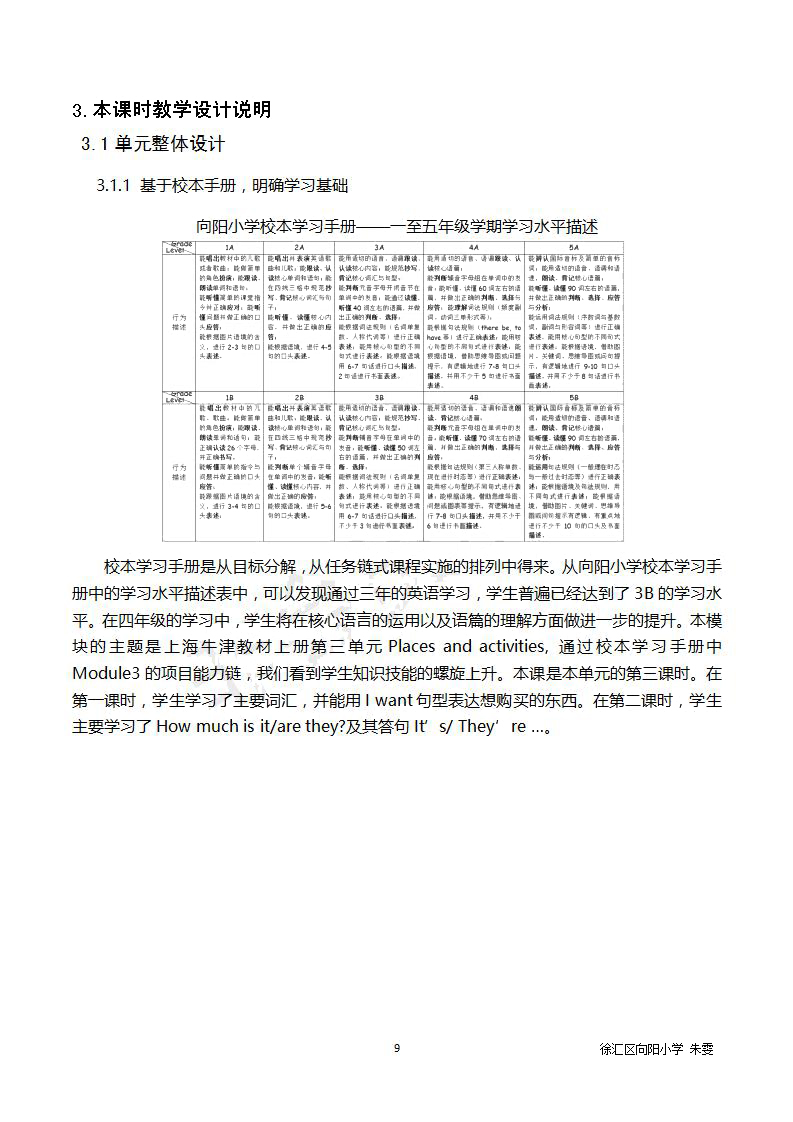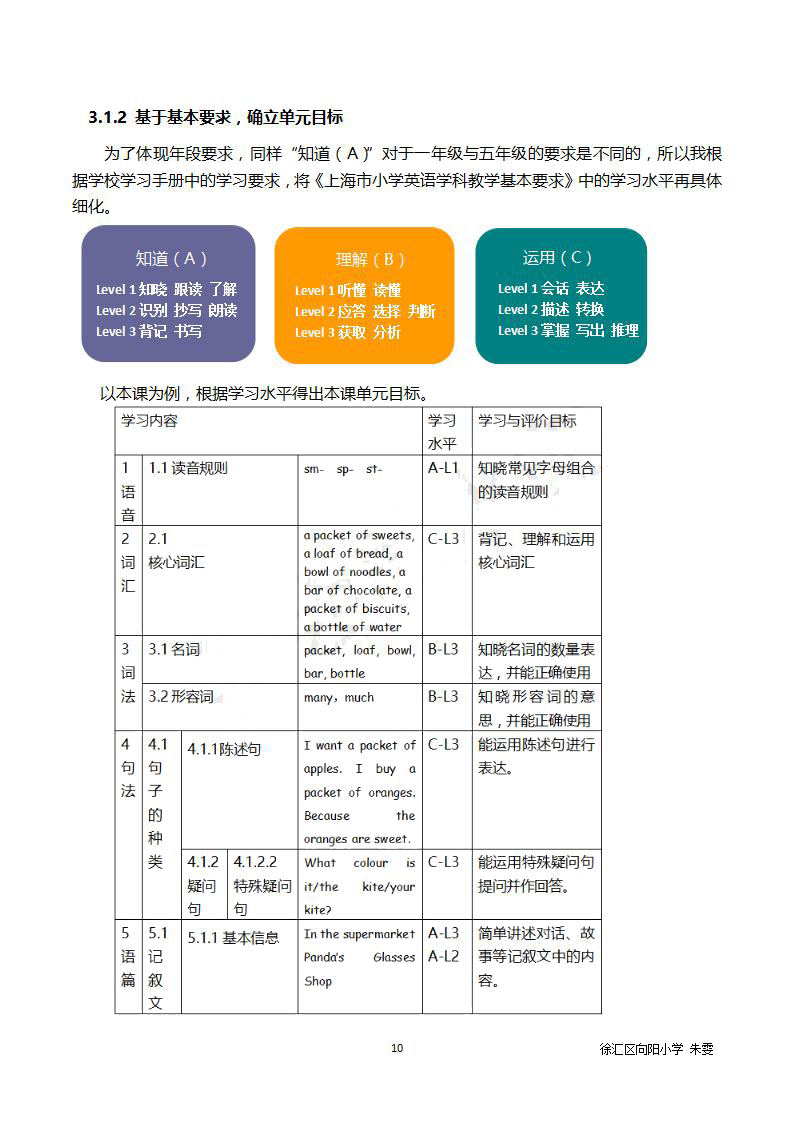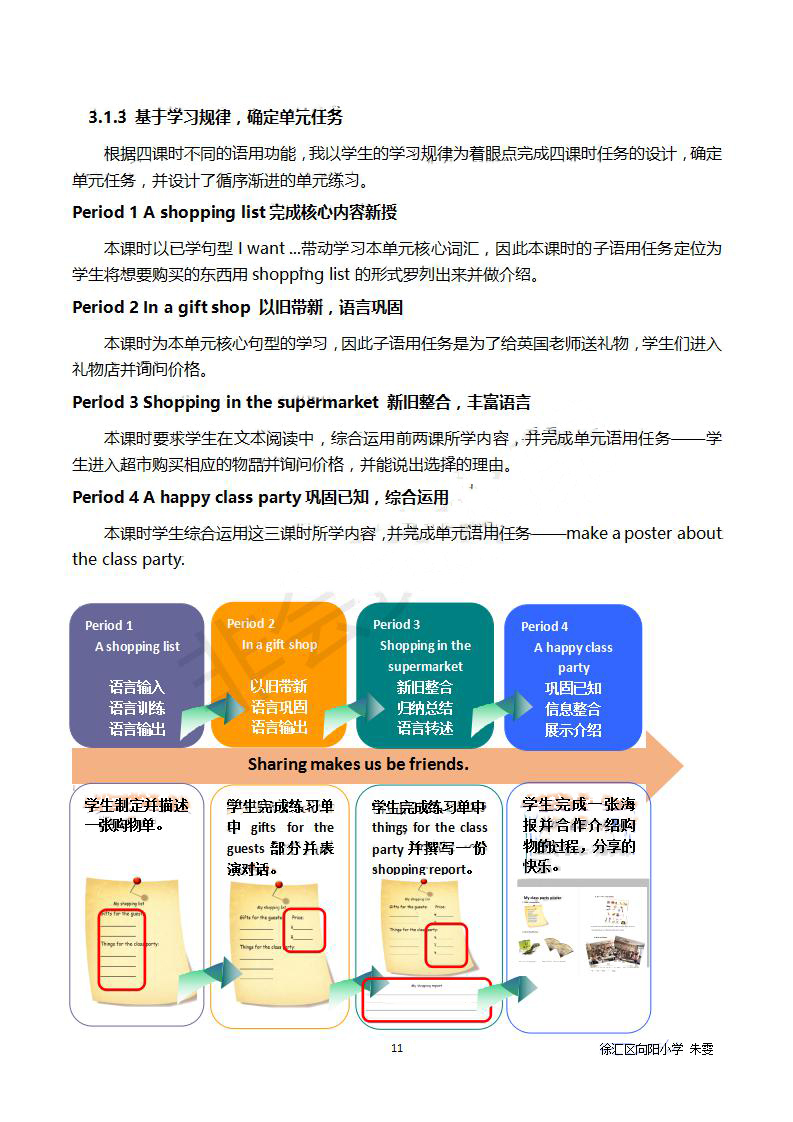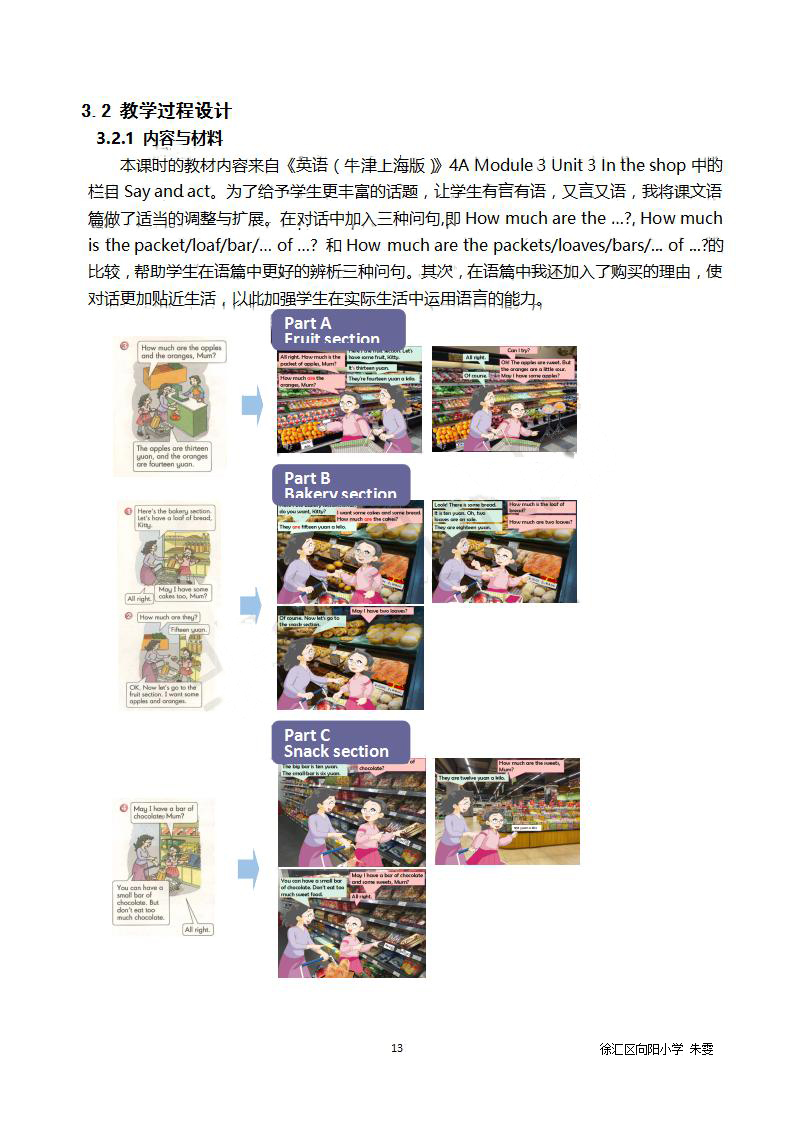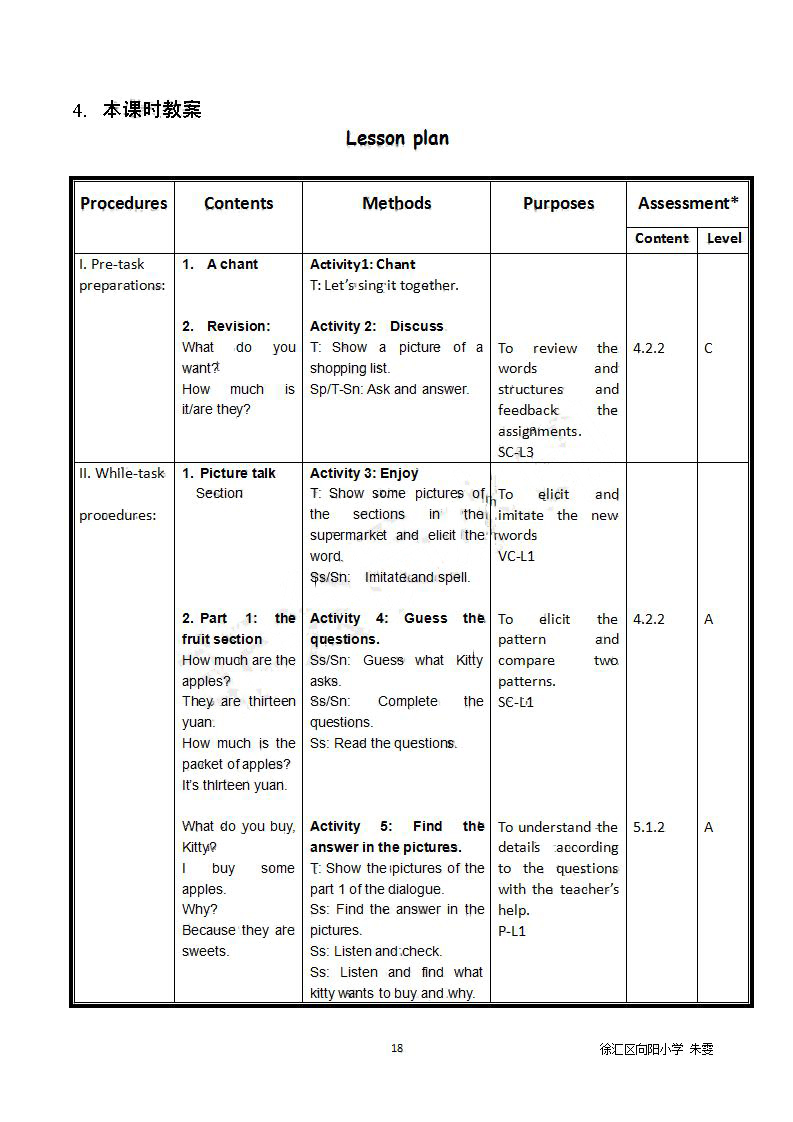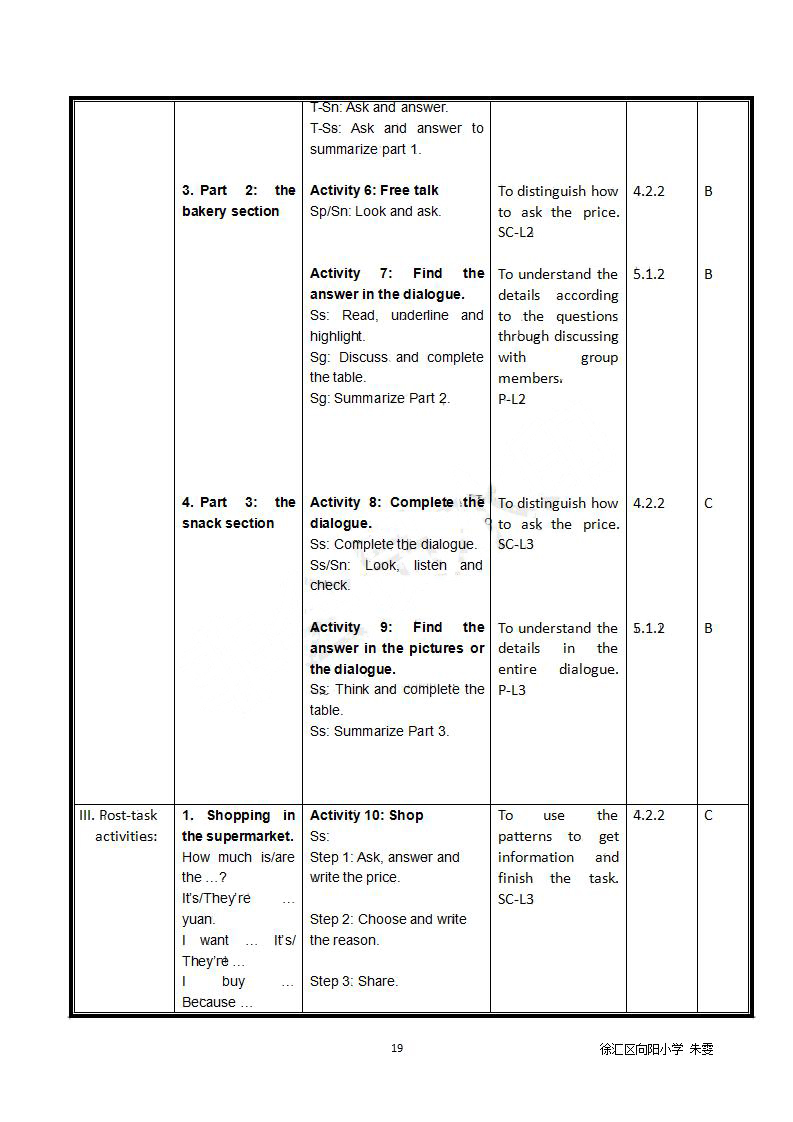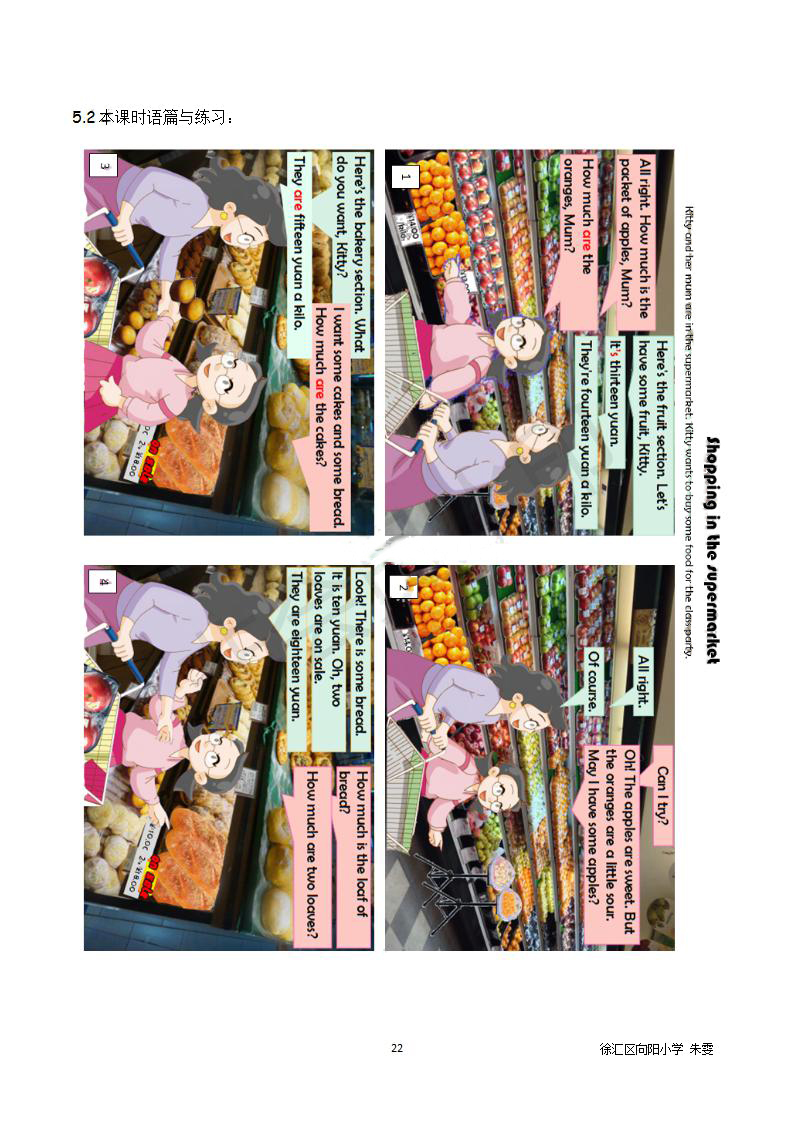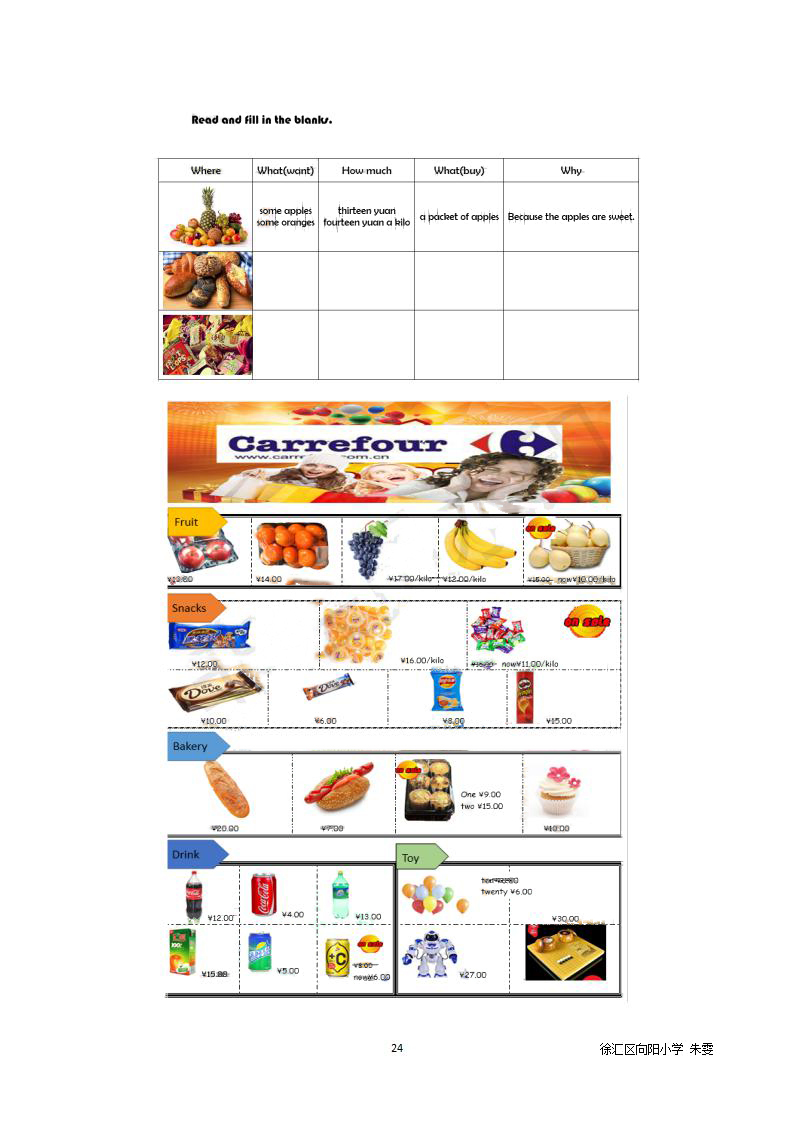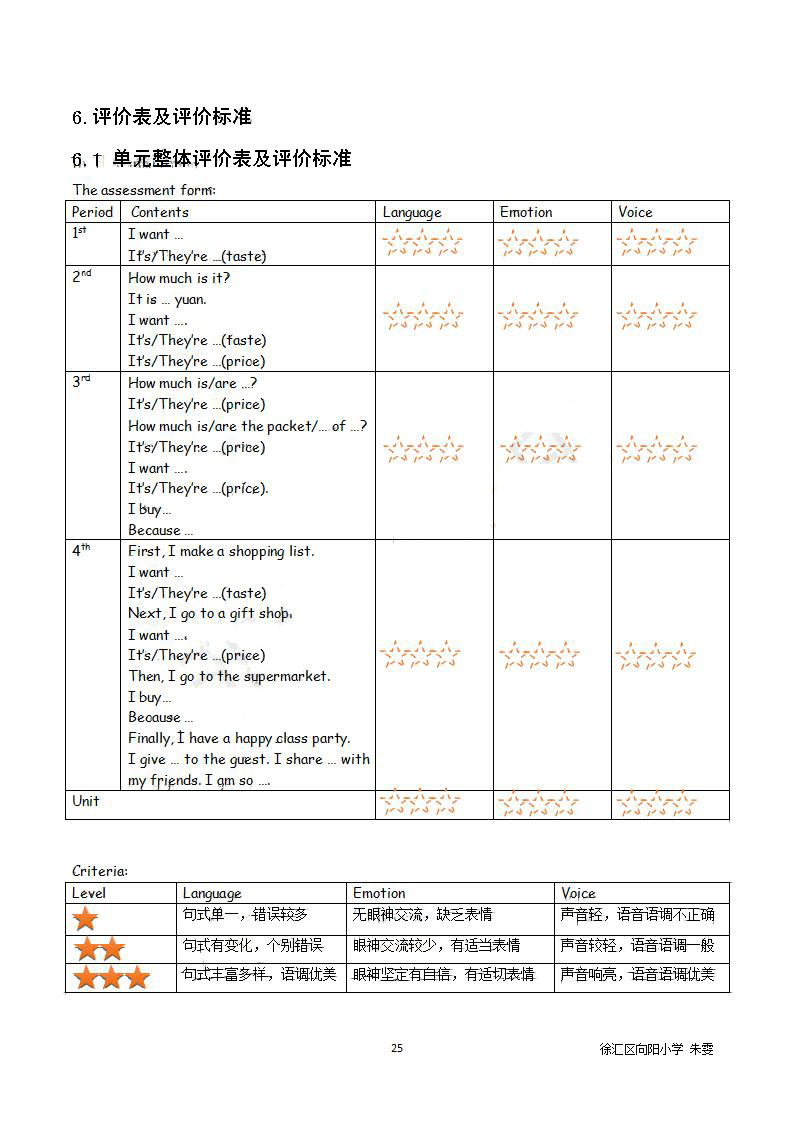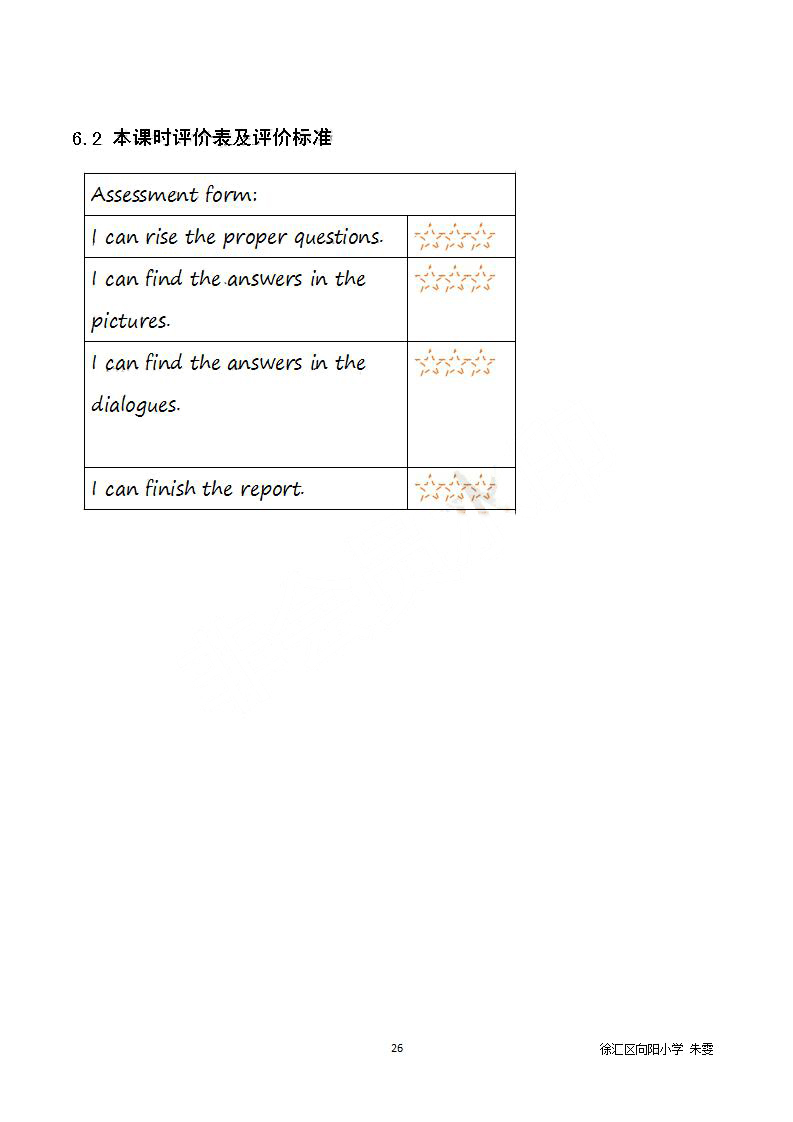
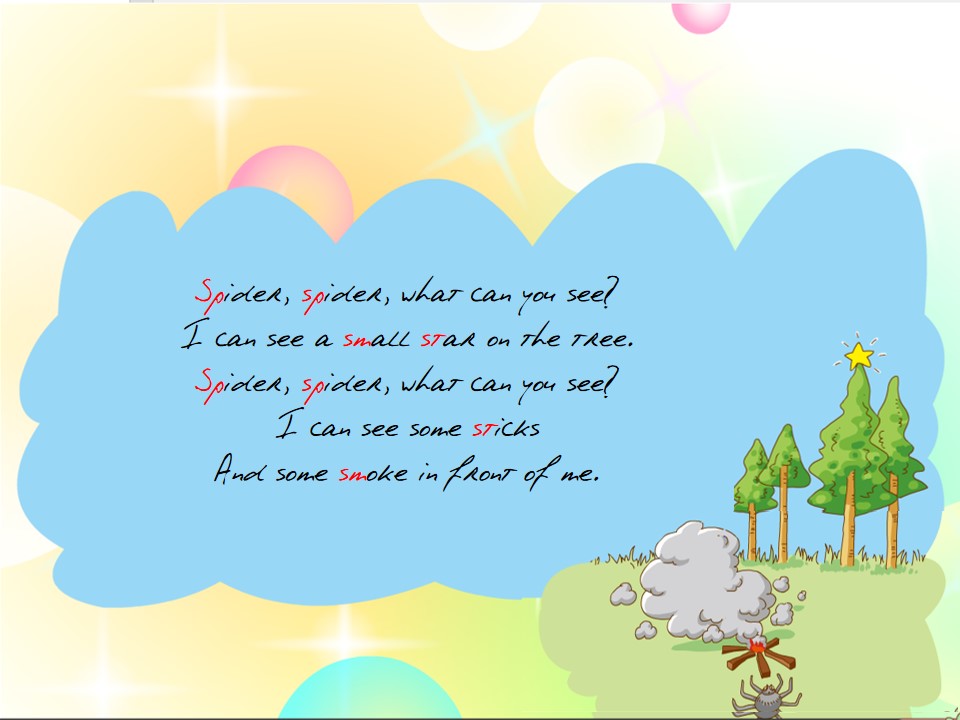
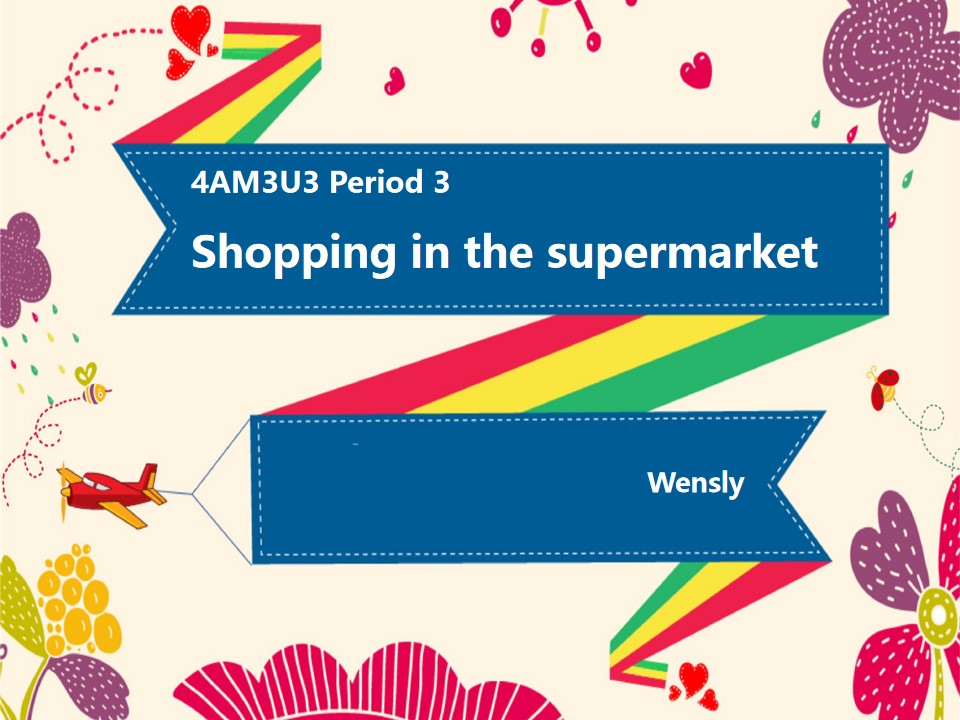
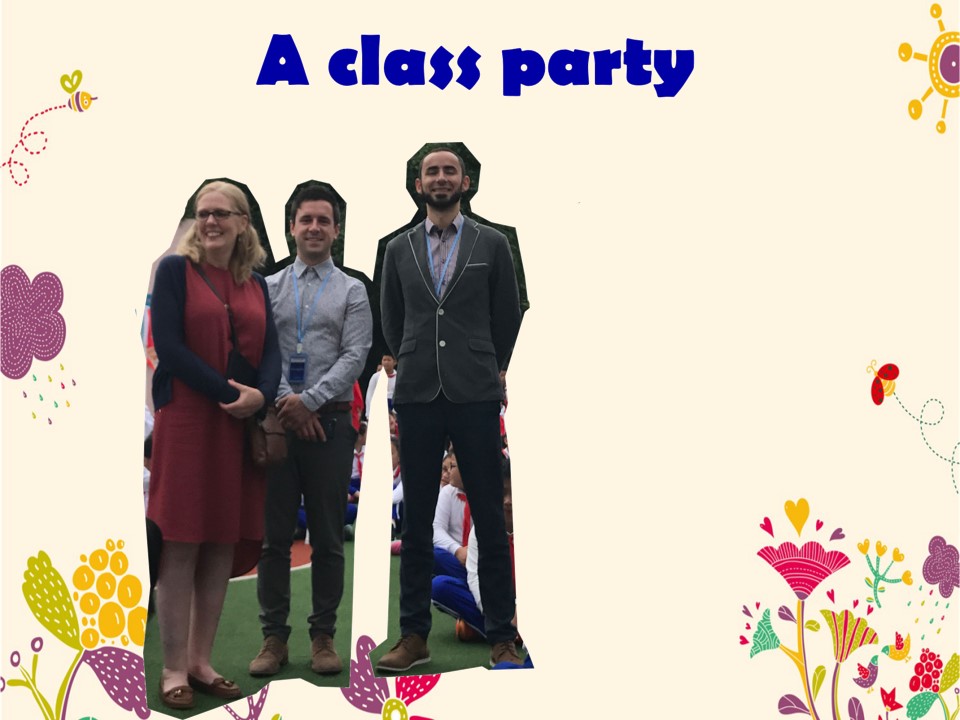
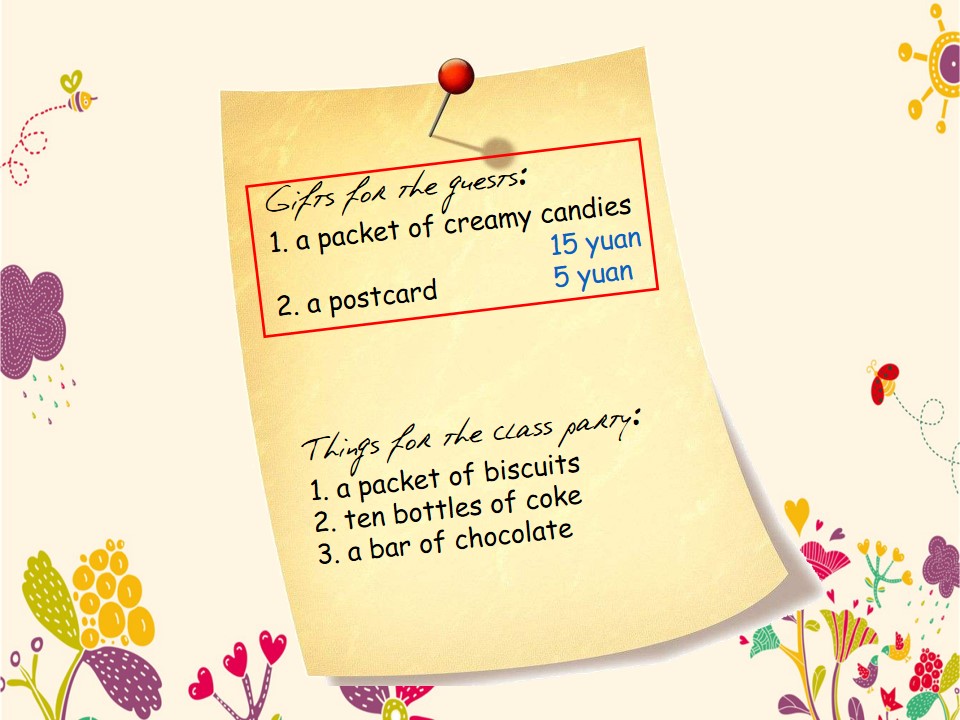
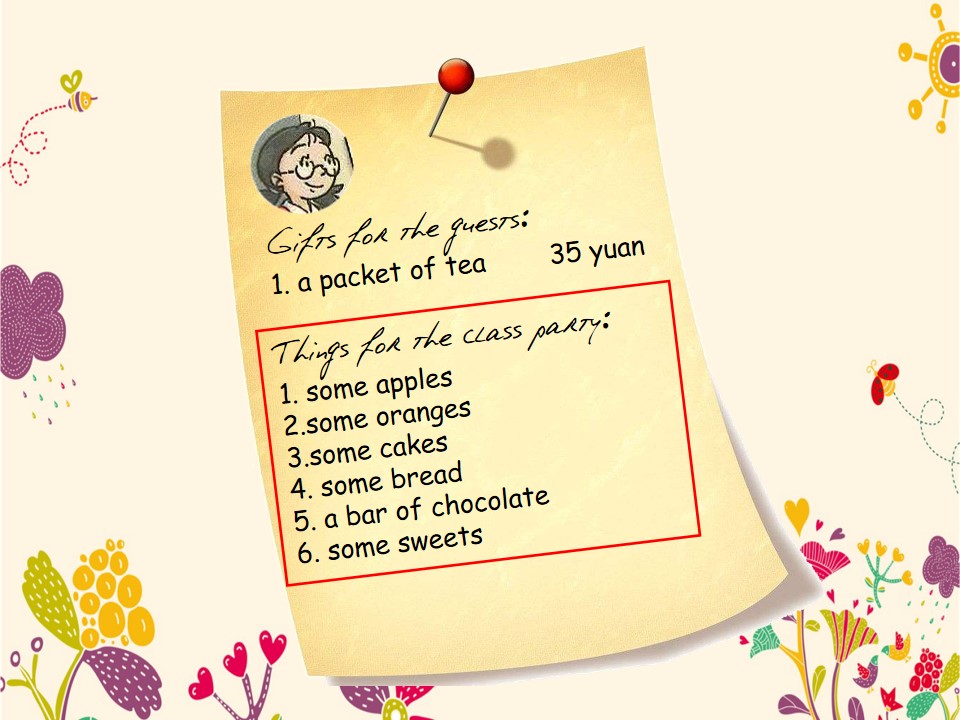


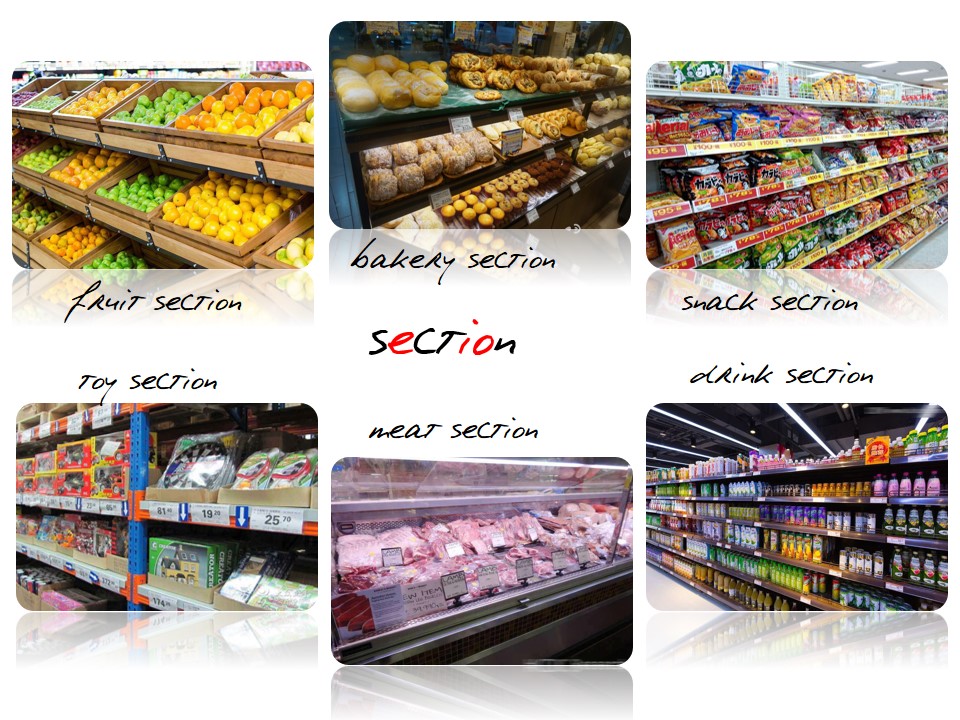

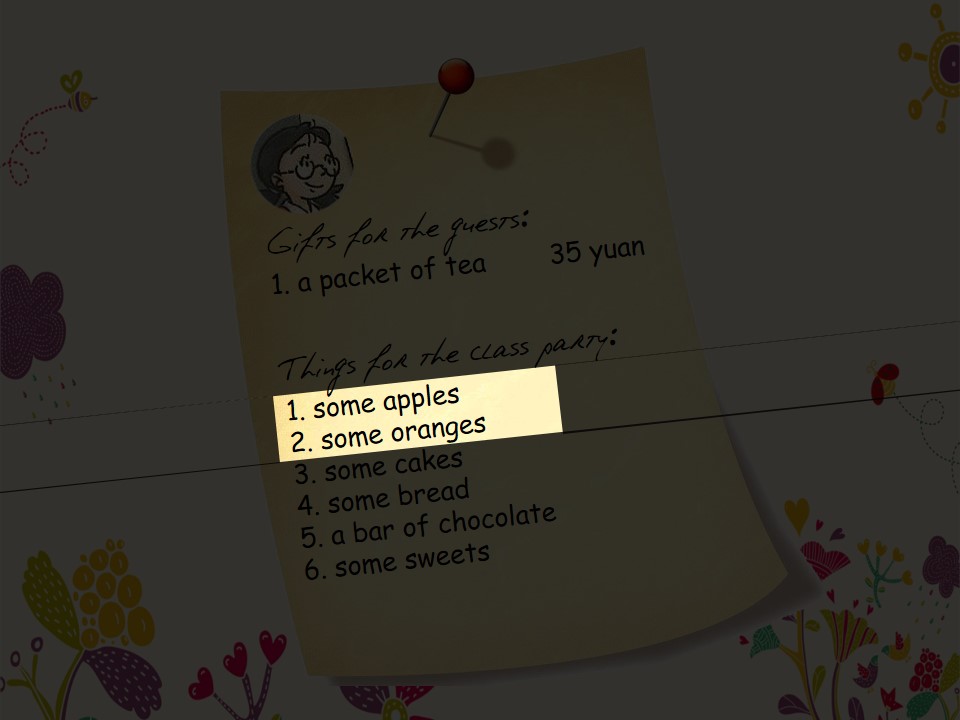

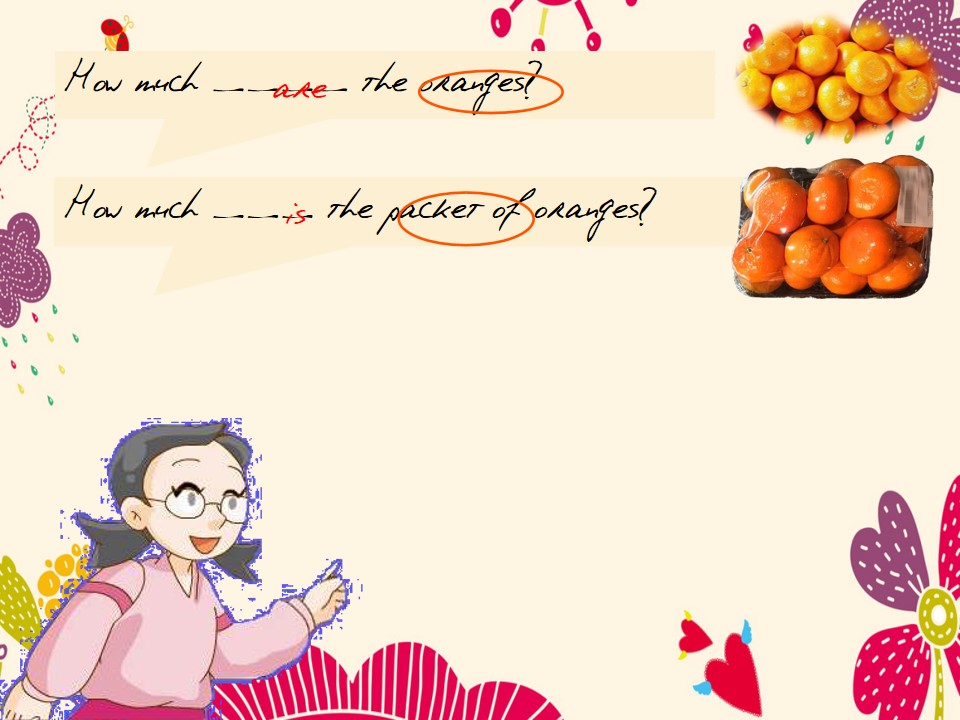

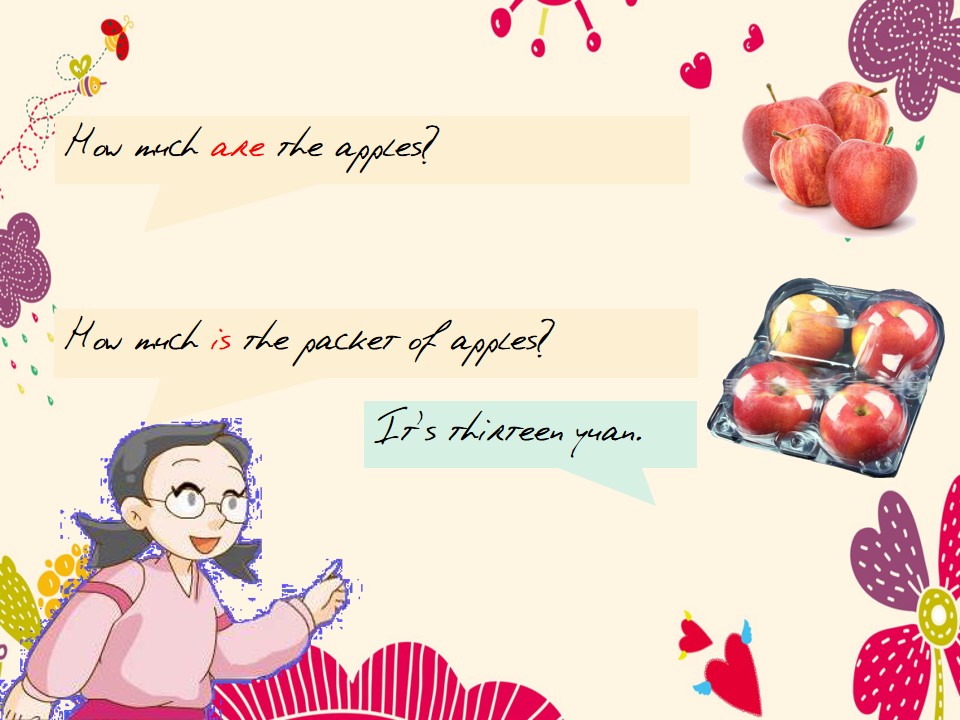
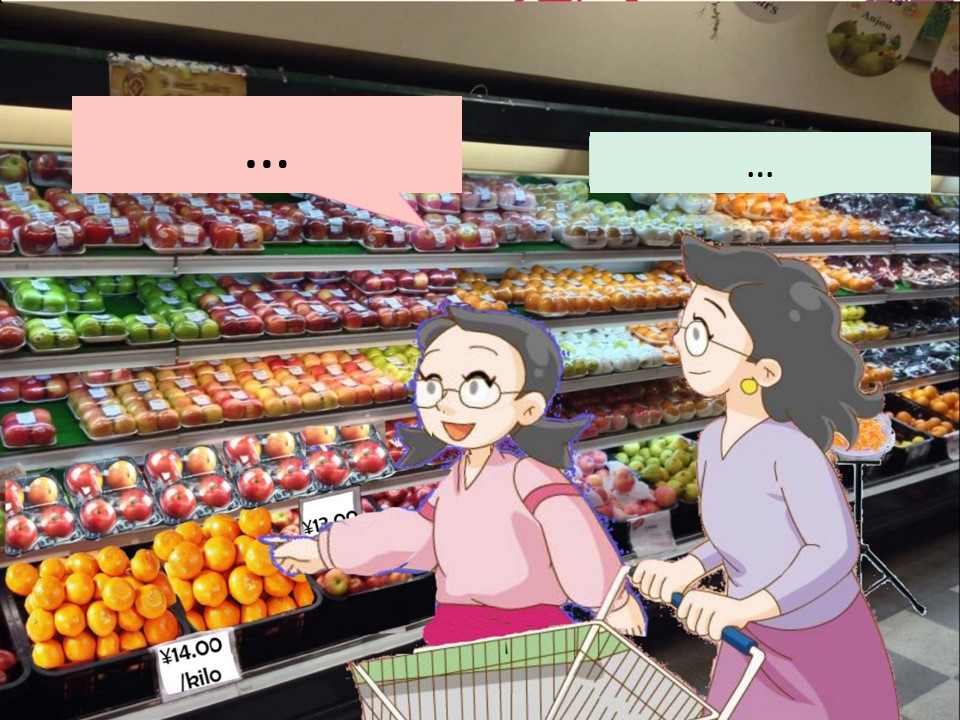

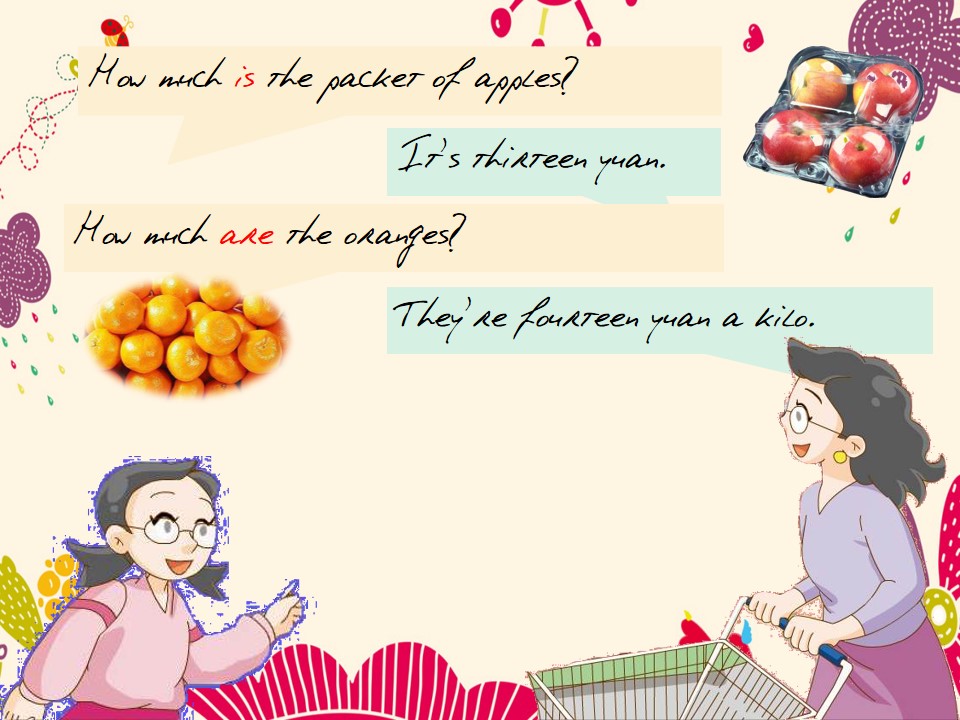

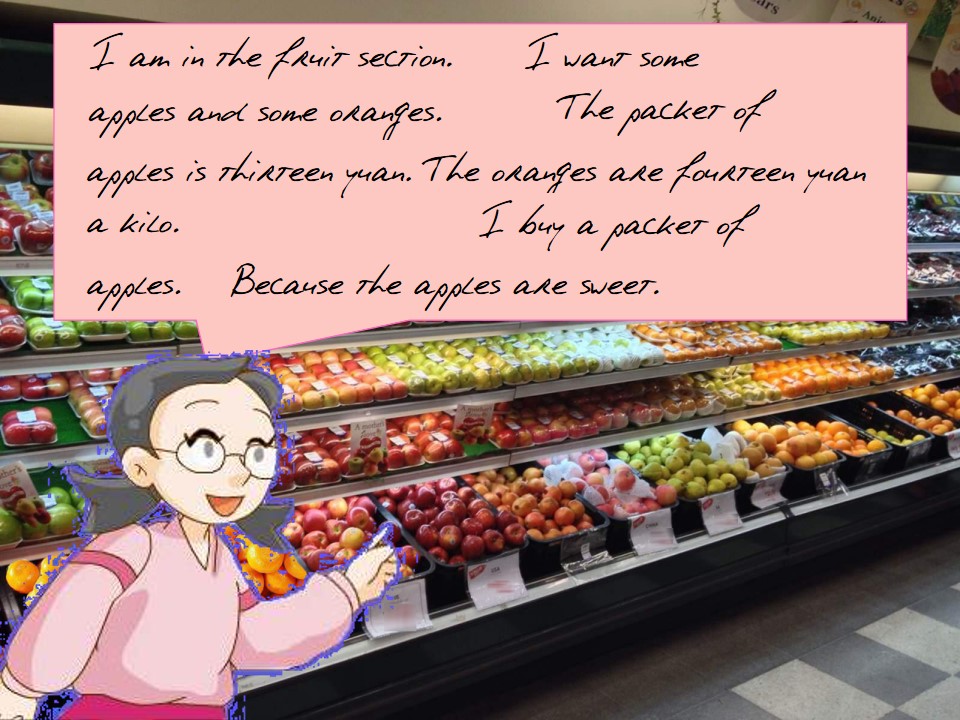

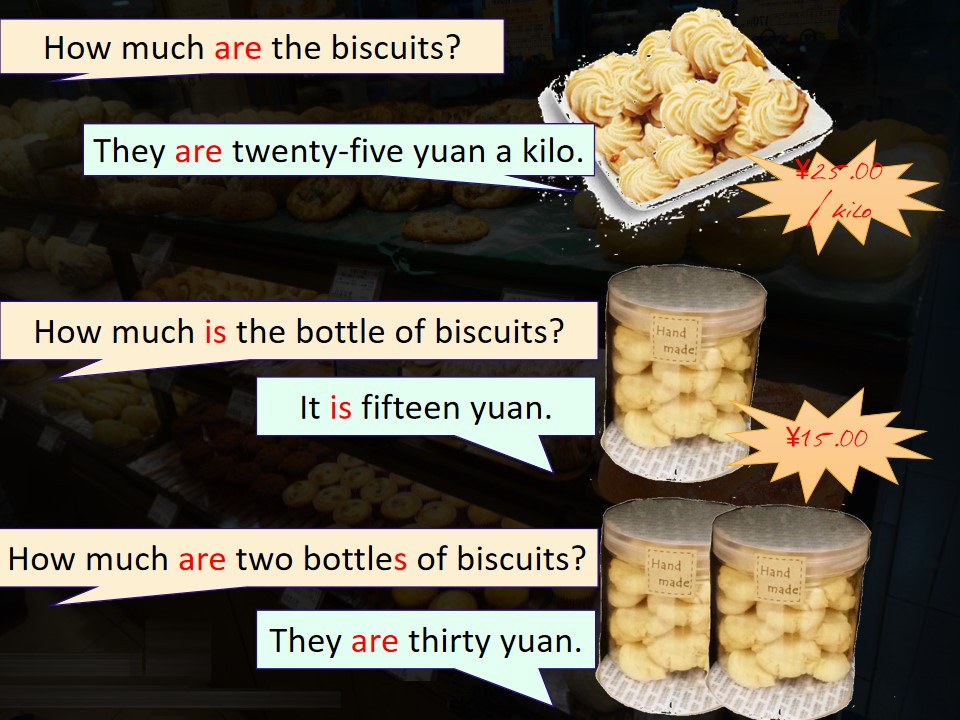




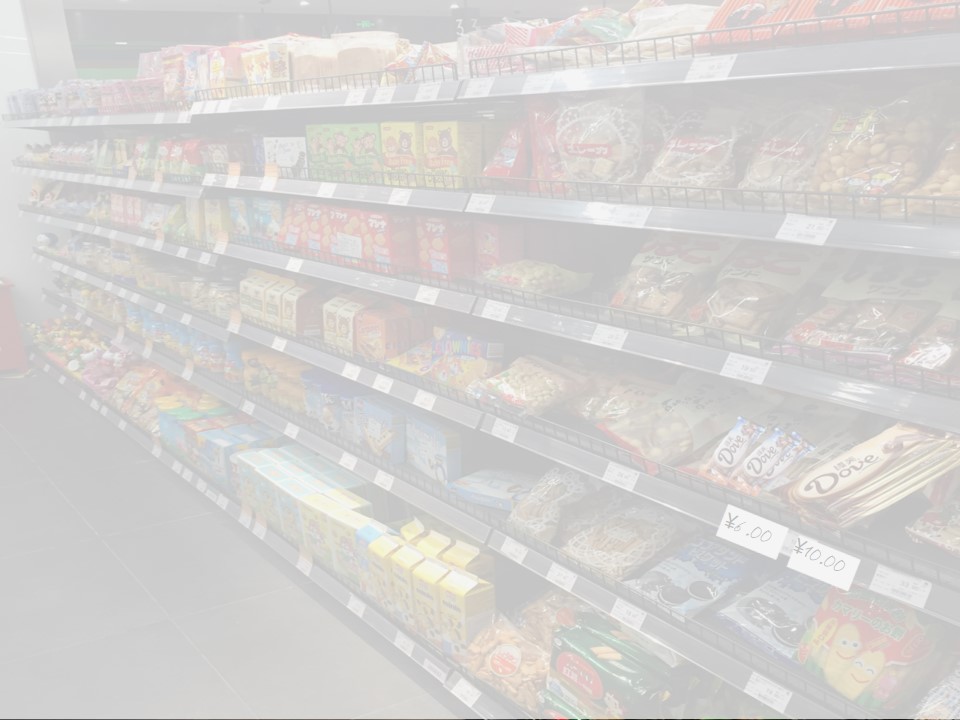

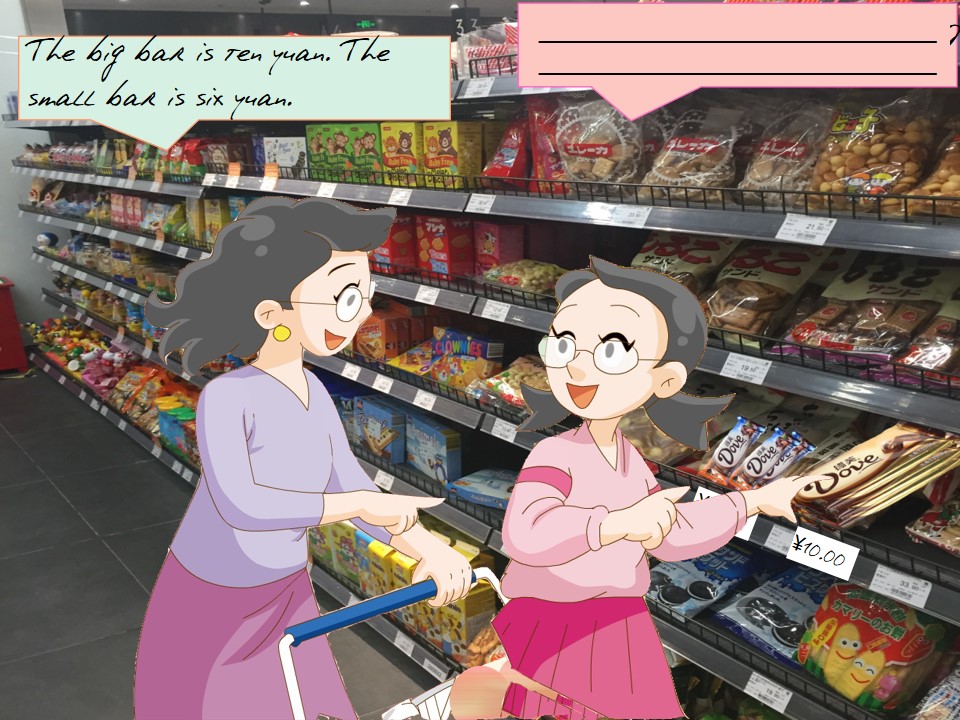



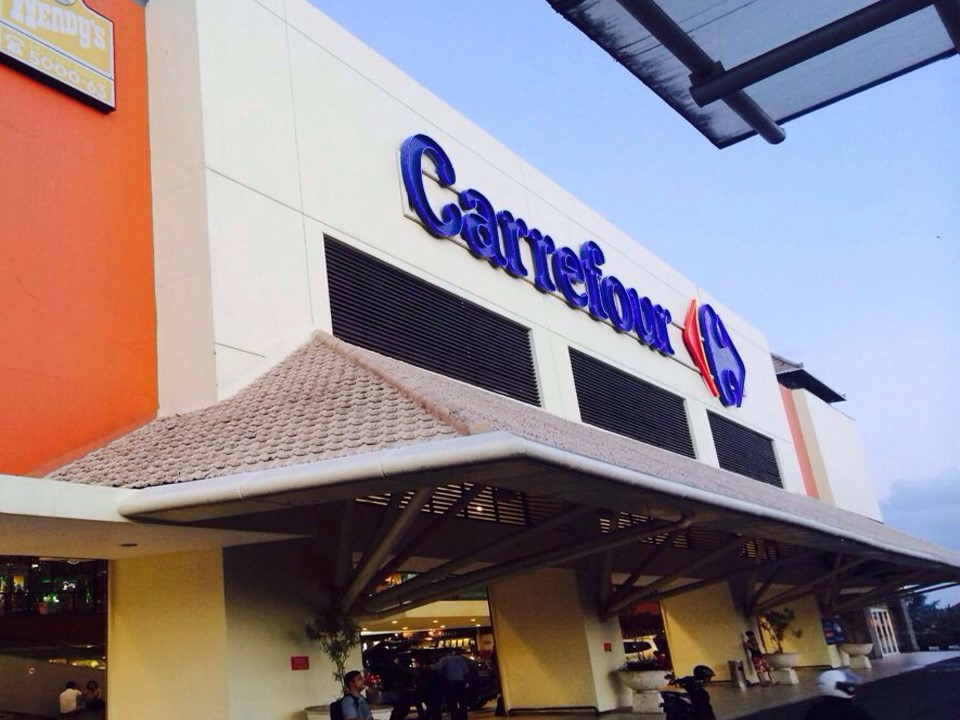
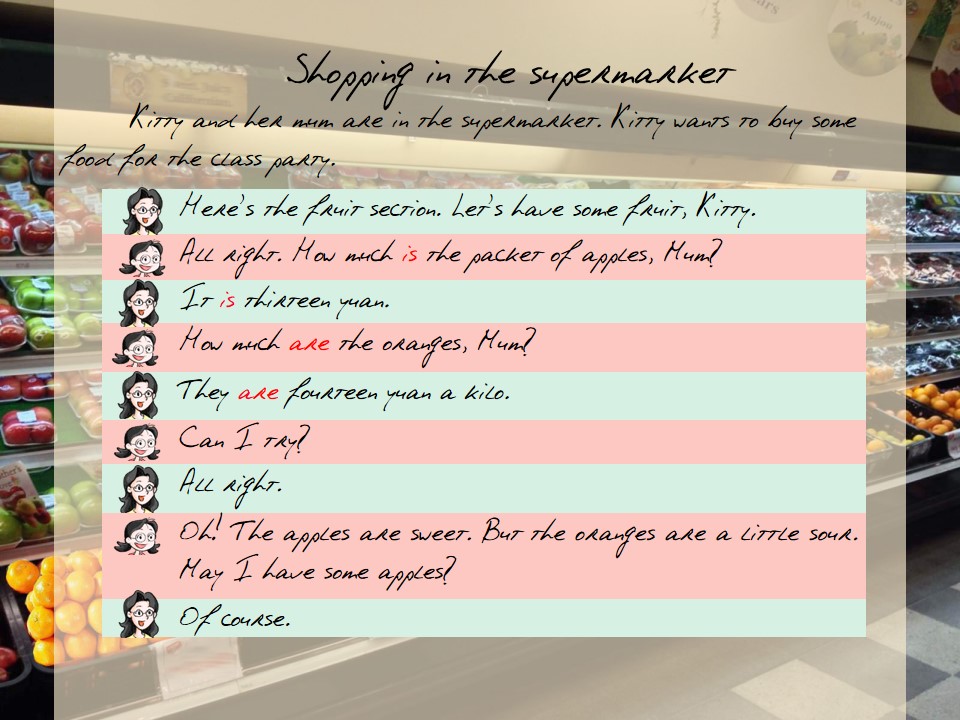


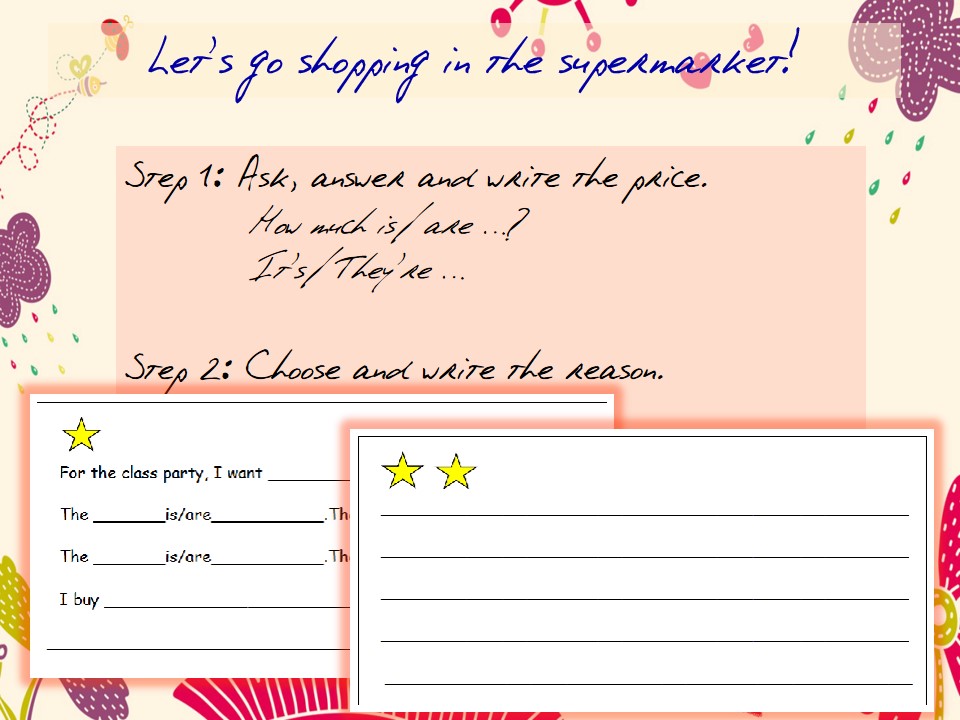
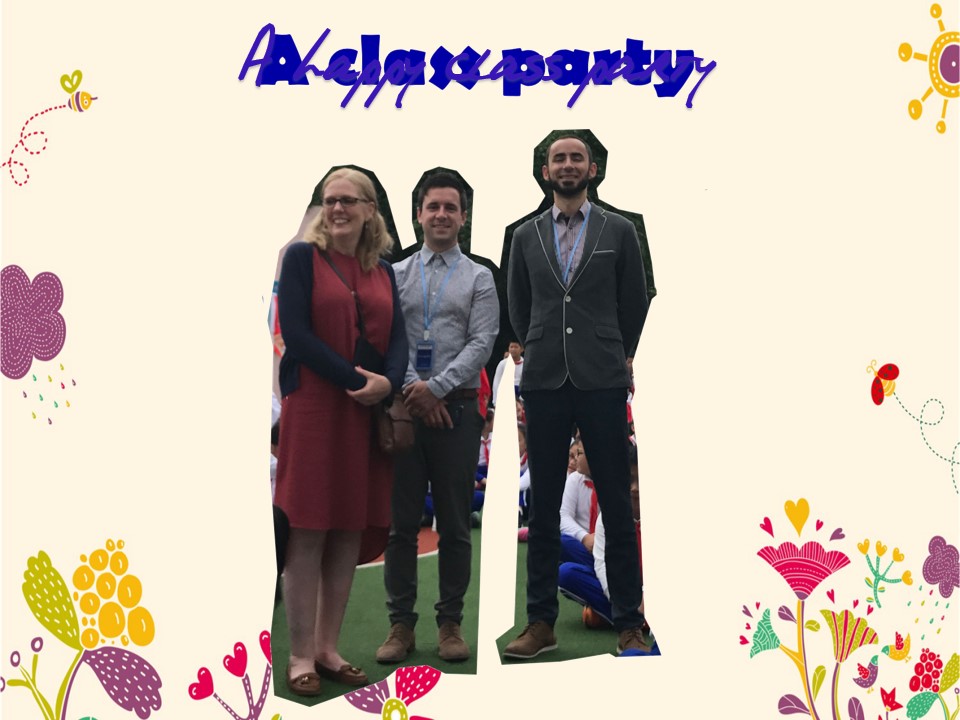



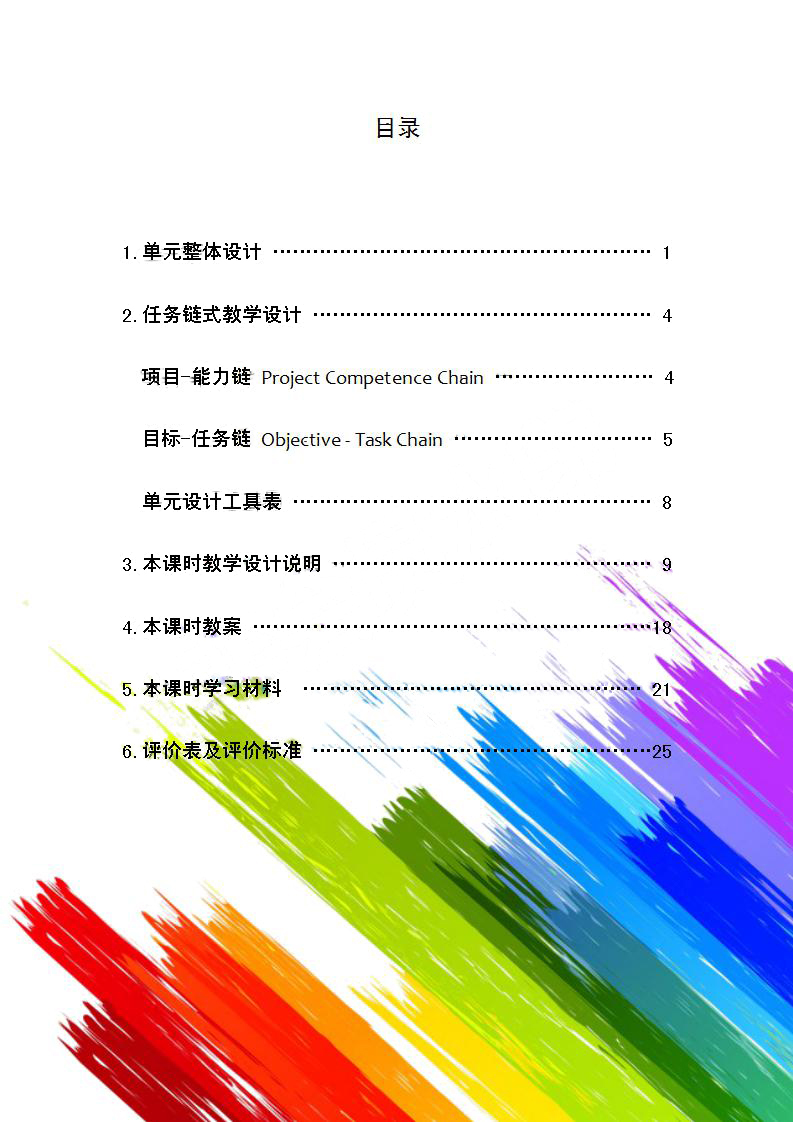
- 单元整体设计
| Period 1 | Period 2 | Period 3 | Period 4 | |
| Objectives | 1. To use noun phrases to refer to the quantity of things.
e.g. a packet of sweets, a loaf of bread, a bowl of noodles, a bar of chocolate, a bottle of water 2. To use formulaic expressions in context. e.g. I want … 3. To use noun to identify specialties of China. e.g. chopsticks, folding fan, moon cake, tea, candy, model 4. To identify the pronunciations of ‘sm’, ‘sp’, ‘st’. |
1. To use wh-questions to find out the price of things.
e.g How much is it/ are they? 2. To use modeled sentences to give the price of things. e.g. It is/ They are … yuan. 3. To use formulaic expressions in context. e.g. I want …
|
1. To use phrases to identify the different part of the supermarket.
e.g. the bakery section, the fruit section, the snacks section 2. To use wh-questions to find out the price of things. e.g. How much is/are the …? 3. To use modeled sentences to give the price of things. e.g. It’s/They’re … yuan. 4. To use modeled sentences to give reasons and write a shopping report. e.g. I buy … Because … 5. To find out the details from the pictures and the dialogues.
|
1. To use adjective to identify the specific things.
e.g. How much is/are the …? 2. To use modeled sentences to give the price of things. e.g. It’s/They’re … yuan. 3. To use modeled sentences to give reasons. e.g. I buy … Because … 4. To use formulaic expressions in context. e.g. I give … to … I am so … |
| Content | OE 4A
Student book P42 Listen and enjoy P42 Look and learn P46 Learn the sounds |
OE 4A
Student book P43 Look and say P43 Ask and answer P46 Play a game |
OE 4A
Student book P44 Say and act
|
OE 4A
Student book P45 Read a story
|
| Topic | A shopping list | In a gift shop | Shopping in the supermarket | A happy class party |
| Use of
language |
To make and introduce a shopping list by using the core words and the sentences they’ve learnt before.
In class: Different feedbacks of pair works and group works. After class: To make and introduce a shopping list. |
To complete the list ‘Gifts for the guests’ and make a dialogue in the gift shop.
In class: Different feedbacks of pair works and make a dialogue. After class: Write about the gift. |
To complete the list ‘Things for the party’ and make a shopping report.
In class: Different feedbacks of dialogue and description. After class: Write a shopping report and read it to your parents. |
To make a poster to introduce the process of shopping and the happiness of sharing.
In class: Different feedbacks of pair works and description. After class: Share your poster to other group or your parents. |
| Procedure | Pre-task preparations:
Warming up While-task procedures: 1. <new guests> Phrases: a packet of sweets, a loaf of bread, a bowl of noodles, a bar of chocolate, a bottle of water 新授词汇,记忆语言结构 2. < A shopping list> Patterns: I want … It’s/They’re … 二次输入,尝试使用语言 Post-task activities: A shopping list 运用语言,完成购物单并作介绍。 |
Pre-task preparations:
Homework-checking 检测前课时学习情况 While-task procedures : 1. <In a gift shop> part A Patterns: How much is it/are they …? 对话推进,新授句型 2. <In a gift shop> part B 对话推进,运用语言 Post-task activities: My gift 运用语言,完成gifts for the guests表格并作介绍。 |
Pre-task preparations:
Homework-checking 检测前课时学习情况 While-task procedures: 1. <In the fruit section> 新授句型, 对比句 型,寻找信息 2. <In the bakery section> 运用句型,合作找出信息 3. <In the snack section> 运用句型,自主提炼信息 Post-task activities: My shopping report 运用语言,完成shopping report并作介绍。 |
Pre-task preparations:
Homework-checking 检测前课时学习情况 While-task procedures: 1. <Make a shopping list.> 2. <Go to the gift shop.> 3. <Go to the supermarket.> 4. <Give and share.> Post-task activities: My class party poster 运用语言,完成poster并作介绍。 |
| Board design | M3U3 Shopping
Period 1 A shopping list I want … It’s/They’re … a packet of sweets a loaf of bread a bowl of noodles a bar of chocolate a bottle of water
|
M3U3 Shopping
Period 2 In a gift shop I want … How much is it/are they? It’s/They’re … yuan.
|
M3U3 Shopping
Period 3 Shopping in the supermarket
|
M3U3 Shopping
Period 4 A happy class party 1. Make a shopping list. 2. Go to the gift shop. I want … It’s/They’re … 3. Go to the supermarket. I buy … Because … 4. Give and share. I give … to the guest. I share … with my friends. I am so happy. |
| Assessment | Speaking and writing:
To describe the shopping list.
e.g., I want a packet of sweets/ a loaf of bread/ a bowl of noodles/ a bar of chocolate/ a bottle of water. It’s/They’re sweet/yummy/nice/…
|
Speaking and writing
To talk about the gifts for the guests. e.g., Speaking: May I have a small packet of sweets, please. How much is it? It is … yuan. Here you are. Thank you.
Writing: How much is it? It is … yuan. I want a small packet of sweets. It is twelve yuan. |
Speaking
To talk about the things for the party. Writing: To make a shopping report. e.g., Speaking: How much is the packet of apples? It is thirteen yuan. How much are the oranges? They are fourteen yuan. Don’t eat too much chocolate.
Writing: How much is the packet of apples? It is thirteen yuan. How much are the oranges? They are fourteen yuan. I want some apples and some oranges. The packet of apples is thirteen yuan. The oranges are fourteen yuan. I buy the packet of apples. Because they are sweet.
|
Speaking
To talk about the poster. Writing: To introduce the process of shopping and the happiness of sharing. e.g., Speaking: How much is the big pair of glasses? It is twenty yuan. How much is the pair of red glasses? It is ten yuan. Speaking: &Writing: First, I make a shopping list. I want … It’s/They’re …(taste) Next, I go to a gift shop. I want …. It’s/They’re …(price) Then, I go to the supermarket. I buy… Because … Finally, I have a happy class party. I give … to the guest. I share … with my friends. I am so …. |
| Emotion | Sharing makes us be friends. | |||
- 任务链式教学设计
Project – Competence Chain(项目-能力链)
OE BOOK 4A Module 3 Places and activities
| Grade | Projects | Competences |
| 5 | “My City”
To make a dialogue about asking the way. |
l To use nouns to identify places, clothes, illnesses.
l To use modeled sentences to ask for directions, suggestions and advice. l To use imperatives to give directions. l To use formulaic expressions to ask and express. |
| 4 | “My Neibourhood”
To illustrate the picture, mark a map and introduce it. |
l To use nouns to identify different places.
l To use modeled sentences to describe existence. l To use noun phrases to refer to the quantity of things. l To use wh-questions to find out the price of things. l To use formulaic expressions in context. |
| 3 | “My School”
Write about my school. |
l To use nouns to identify objects and use adjectives to identify objects.
l To use modeled patterns to describe one’s favourite place in a school. l To ask wh-questions to find out the specific information. l Learn the indefinite articles a and an |
| 2 | “My Home”
To make a poster. |
l To use nouns to identify objects
l To use modeled sentences to identify positions. l To use wh-questions to find out specific information l To use modeled sentences to describe existence. l To use imperatives to give simple instructions |
| 1 | “My Bag”
To colour one of the pictures individually and then make a dialogue in pairs. |
l To name the quantity of the objects.
l To use wh-questions to find out the quantity of things l To use formulaic expressions to make dialogue |
Objective – Task Chain(目标-任务链 )
OE BOOK 4A Module 3 Places and activities
| Grade 4
Project: To illustrate the picture, mark a map and introduce it. Learning objectives: l To use nouns to identify different places. l To use modeled sentences to describe existence. l To use noun phrases to refer to the quantity of things. l To use wh-questions to find out the prices of things. l To use formulaic expressions in context.
|
||
| Unit 1 In our school
Task: To draw a plan of our school and write about it. Learning objectives: 1. To use nouns to identify different places in a school. 2. To use prepositions to identify positions 3. To use modeled sentences to describe school. 4. To use wh-questions to find out specific information. 5. To identify the pronunciations of ‘fr’, ‘gr’ ‘tr’ in words.
|
Unit 2 Around my home
Task: To make a guide map and introduce it. Learning objectives: 1. To use nouns to identify different places in a neighbourhood. 2. To use modeled sentences to identify positions. 3. To use yes/no questions to elicit a positive or negative response. 4. To use modeled patterns to describe existence 5. To use modeled patterns to describe one’s favorite places. 6. To identify the pronunciations of ‘sl’, ‘sn’, ‘sw’ |
Unit 3 In the shop
Task: To make a poster to introduce the process of shopping and the happiness of sharing. Learning objectives: 1. To use noun phrases to refer to the quantity of things. 2. To use wh-questions to find out the price of things. 3. To use modeled sentences to give the price of things. 4. To use formulaic expressions in context. 5. To identify the pronunciations of ‘sm’, ‘sp’, ‘st’.
|
OE BOOK 4A Module 3 Places and activities
| Periods & Sub-topics | Period 1
A shopping list |
Period 2
In the gift shop |
Period 3
Shopping in the supermarket |
Period 4
A happy class party |
| Sub-tasks | To make and introduce a shopping list. | To role-play a dialogue in the gift shop. | To make a shopping report for the class party. | To make a poster to introduce the process of shopping and the happiness of sharing. |
| Learning Objectives | 1. To use noun phrases to refer to the quantity of things.
e.g. a packet of sweets, a loaf of bread, a bowl of noodles, a bar of chocolate, a bottle of water 2. To use formulaic expressions in context. e.g. I want … 3. To use noun to identify specialties of China. e.g. chopsticks, folding fan, moon cake, tea, candy, model 4. To identify the pronunciations of ‘sm’, ‘sp’, ‘st’.
|
1. To use wh-questions to find out the price of things.
e.g How much is it/ are they? 2. To use modeled sentences to give the price of things. e.g. It is/ They are … yuan. 3. To use formulaic expressions in context. e.g. I want…
|
3. To use phrases to identify the different part of the supermarket.
e.g. the bakery section, the fruit section, the snacks section 2. To use wh-questions to find out the price of things. e.g. How much is/are the …? 3. To use modeled sentences to give the price of things. e.g. It’s/They’re … yuan. 4. To use modeled sentences to give reasons. e.g. I buy … Because …
|
1. To use adjective to identify the specific things.
e.g. How much is/are …? 2. To use modeled sentences to give the price of things. e.g. It’s/They’re … yuan. 3. To use modeled sentences to give reasons. e.g. I buy … Because … 4. To use formulaic expressions in context. e.g. I give … to … I am so …
|
| Core contents: | Words: chopsticks, folding fan, moon cake, tea, candy, model
Phrases: a packet of sweets, a loaf of bread, a bowl of noodles, a bar of chocolate, a bottle of water Patterns: I want … |
Sounds: sm-,sp-, st-
Phrases: the food shop, the toy shop, the stationary shop, the clothe shop Patterns: How much is it/are they? It is/ They are … I want to give them …
|
Phrases: the bakery section, the fruit section, the snacks section
Patterns: How much is/are the …? It is/ They are … I want to buy … Because …
|
Words: mole, magic
Patterns: How much is the big packet of apples? How much is the packet of big apples? It’s/They’re … yuan. I have …. I want to buy … Because … I want to buy … Because … |
| Discourse | Speaking:
I want a packet of sweets/ a loaf of bread/ a bowl of noodles/ a bar of chocolate/ a bottle of water. It’s/They’re sweet/yummy/nice/…
Writing: I want a packet of sweets/ a loaf of bread/ a bowl of noodles/ a bar of chocolate/ a bottle of water. It’s/They’re sweet/yummy/nice/…
|
Speaking:
May I have a small packet of sweets, please. How much is it? It is … yuan. Here you are. Thank you.
Writing: How much is it? It is … yuan. I want a small packet of sweets. It is twelve yuan. |
Speaking:
How much is the packet of apples? It is thirteen yuan. How much are the oranges? They are fourteen yuan. Don’t eat too much chocolate.
Writing: How much is the packet of apples? It is thirteen yuan. How much are the oranges? They are fourteen yuan. I want some apples and some oranges. The packet of apples is thirteen yuan. The oranges are fourteen yuan. I buy the packet of apples. Because they are sweet. |
Speaking:
How much is the big pair of glasses? It is twenty yuan. How much is the pair of red glasses? It is ten yuan. Speaking: &Writing: First, I make a shopping list. I want … It’s/They’re …(taste) Next, I go to a gift shop. I want …. It’s/They’re …(price) Then, I go to the supermarket. I buy… Because … Finally, I have a happy class party. I give … to the guest. I share … with my friends. I am so …. |
| Materials | SB:
P42 Listen and enjoy P46 Learn the sounds WB: P61 E
|
SB:
P43 Look and say Ask and answer P46 Play a game WB: P59 A,B P62 F, P63 G |
SB:
P44 Say and act
|
SB:
P45 Read a story WB: P60 C,D P64 task |
